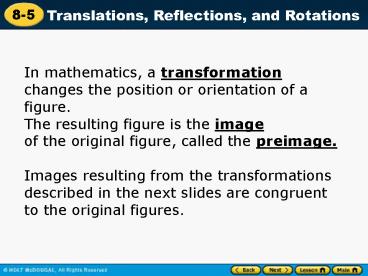In mathematics, a transformation
1 / 21
Title:
In mathematics, a transformation
Description:
In mathematics, a transformation changes the position or orientation of a figure. The resulting figure is the image of the original figure, called the preimage. –
Number of Views:63
Avg rating:3.0/5.0
Title: In mathematics, a transformation
1
In mathematics, a transformation changes the
position or orientation of a figure. The
resulting figure is the image of the original
figure, called the preimage. Images resulting
from the transformations described in the next
slides are congruent to the original figures.
2
Types of Transformations
Translation The figure slides along a straight
line without turning.
3
Types of Transformations
Reflection The figure flips across a line of
reflection, creating a mirror image.
4
Types of Transformations
Rotation The figure turns around a fixed point.
5
Additional Example 1 Identifying Types of
Transformations
Identify each type of transformation.
B.
A.
The figure flips across the y-axis.
The figure slides along a straight line.
6
Check It Out Example 1
Identify the type of transformation.
7
Additional Example 2 Graphing Transformations on
a Coordinate Plane
Graph the translation of quadrilateral ABCD 4
units left and 2 units down.
8
Write the coordinate of the vertices of the image.
Quadrilateral ABCD (x 4, y 2) ABCD
A(1, 3)
B(4, 4)
C(4, 1)
D(1, 1)
9
Reading Math
A is read A prime and is used to represent the
point on the image that corresponds to point A of
the original figure
10
Check It Out Example 2
Graph the translation of quadrilateral ABCD 5
units left and 3 units down.
11
Additional Example 3 Graphing Reflections on a
Coordinate Plane
Graph the reflection of the figure across the
indicated axis. Write the coordinates of the
vertices of the image.
12
Additional Example 3 Continued
A. x-axis
Note The x-coordinates of the corresponding
vertices are the same, and the y-coordinates of
the corresponding vertices are opposites.
13
Note The y-coordinates of the corresponding
vertices are the same, and the x-coordinates of
the corresponding vertices are opposites.
B. y-axis
14
Check It Out Example 3
Graph the reflection of quadrilateral ABCD across
the x-axis.
15
Additional Example 4 Graphing Rotations on a
Coordinate Plane
Triangle ABC has vertices A(1, 0), B(3, 3), C(5,
0). Rotate ?ABC 180 about the origin. Write the
coordinates of the vertices of the image.
Notice that vertex C is 4 units to the right of
vertex A, and vertex C is 4 units to the left of
vertex A.
16
Check It Out Example 4
Rotate the graph of quadrilateral ABCD 90
clockwise about the origin.
17
Lesson Quiz
- 1. Identify the transformation.
18
2. The figure formed by (5, 6), (1, 6),
and (3, 2) is translated 6 units right and 2
units up. What are the coordinates of the new
figure?
19
- 3. Graph the triangle with vertices A(0, 0),
B(3, 0), C(1, 4). Reflect ?ABC across the
y-axis and give the coordinates of the vertices
of the image.
20
Lesson Quiz for Student Response Systems
- 1. Identify the transformation.
- A. translation
- B. reflection
- C. rotation
- D. none
21
Lesson Quiz for Student Response Systems
- 2. The figure formed by (3, 2), (4, 1), and
(1, 5) is translated 3 units right and 5 units
up. What are the coordinates of the new figure? - A. (6, 3), (7, 4), (4, 10)
- B. (0, 7), (7, 4), (2, 10)
- C. (0, 7), (1, 6), (2, 0)
- D. (6, 3), (1, 6), (4, 0)































